|
|
|
Sort Order |
|
|
|
Items / Page
|
|
|
|
|
|
|
| Srl | Item |
| 1 |
ID:
123729


|
|
|
|
|
| Publication |
2013.
|
| Summary/Abstract |
It has long been known that thorium-232 is a fertile radioactive material that can produce energy in nuclear reactors for conversion to electricity. Thorium-232 is well suited to a variety of reactor types including molten fluoride salt designs, heavy water CANDU configurations, and helium-cooled TRISO-fueled systems.
Among contentious commercial nuclear power issues are the questions of what to do with long-lived radioactive waste and how to minimize weapon proliferation dangers. The substitution of thorium for uranium as fuel in nuclear reactors has significant potential for minimizing both problems.
Thorium is three times more abundant in nature than uranium. Whereas uranium has to be imported, there is enough thorium in the United States alone to provide adequate grid power for many centuries. A well-designed thorium reactor could produce electricity less expensively than a next-generation coal-fired plant or a current-generation uranium-fueled nuclear reactor. Importantly, thorium reactors produce substantially less long-lived radioactive waste than uranium reactors.
Thorium-fueled reactors with molten salt configurations and very high temperature thorium-based TRISO-fueled reactors are both recommended for priority Generation IV funding in the 2030 time frame.
|
|
|
|
|
|
|
|
|
|
|
|
|
|
|
|
| 2 |
ID:
124466


|
|
|
|
|
| Publication |
2013.
|
| Summary/Abstract |
Renewable energy is becoming a priority for Latin America and Caribbean (LAC) countries because of energy challenges such as demand growth, high dependence on imported fossil fuels, and climate change. As of 2010, 12 LAC countries have implemented formal targets for renewable energy deployment. Some of the LAC countries, namely Argentina, Dominican Republic, Ecuador, Honduras, and Nicaragua, are using feed-in tariffs (FITs) to promote renewables. FITs are long-term, guaranteed purchase agreements for green electricity at a price that can provide project developers a reasonable return on investment. FITs are increasingly popular because if designed well, they can mitigate investor risk in renewables. This article presents a low-risk FIT design and then uses this design to benchmark the existing LAC region FITs.
|
|
|
|
|
|
|
|
|
|
|
|
|
|
|
|
| 3 |
ID:
124307


|
|
|
|
|
| Publication |
2013.
|
| Summary/Abstract |
The EU renewable energy (RES) directive sets a target of increasing the share of renewable energy used in the EU to 20% by 2020. The Norwegian goal for the share of renewable energy in 2020 is 67.5%, an increase from 60.1% in 2005. The Norwegian power production is almost solely based on renewable resources and the possibility to change from fossil power plants to renewable power production is almost non-existing. Therefore other measures have to be taken to fulfil the RES directive. Possible ways for Norway to reach its target for 2020 are analysed with a technology-rich, bottom-up energy system model (TIMES-Norway). This new model is developed with a high time resolution among others to be able to analyse intermittent power production. Model results indicate that the RES target can be achieved with a diversity of options including investments in hydropower, wind power, high-voltage power lines for export, various heat pump technologies, energy efficiency measures and increased use of biodiesel in the transportation sector. Hence, it is optimal to invest in a portfolio of technology choices in order to satisfy the RES directive, and not one single technology in one energy sector.
|
|
|
|
|
|
|
|
|
|
|
|
|
|
|
|
| 4 |
ID:
124221


|
|
|
|
|
| Publication |
2013.
|
| Summary/Abstract |
Feed-in Tariffs (FITs) implemented by city councils in the USA have proven an effective means of stimulating installation of renewable-electricity generation capacity at a local level, and may also be effective for New Zealand cities. Though New Zealand has a high proportion of electricity generated renewably, this is mostly from centralized hydroelectricity plants. The suitability of city-level FITs for promoting solar photovoltaic panels in New Zealand is examined. Findings suggest that FITs, with rates obtained using the cost-of-generation method, could be implemented in New Zealand cities at rates comparable to those in successful FIT schemes internationally. The unique structure of New Zealand's liberalized electricity market, however, is likely to make financing FIT schemes at city-level more complex than the equivalent situation in the USA. Benefits of introducing such schemes will include the possibility for purchasers of solar PV systems to calculate returns on investment over the long term, and the streamlining of the grid connection process by reducing the number of authorities involved.
|
|
|
|
|
|
|
|
|
|
|
|
|
|
|
|
| 5 |
ID:
124610


|
|
|
|
|
| Summary/Abstract |
The introduction of smart metering is one of the core elements in recent European policies targeting environmental sustainability and competitiveness of energy markets. Following the roll-out of smart electricity meters, in 2008 the Italian regulator designed an ambitious deployment program also for smart gas meters, that was recently modified in both scope and timing.
This paper assesses Italy's original and current deployment plans, with a specific focus on the results of its cost-benefit analysis. In light of the evidence derived from the literature, we observe that the case for the roll-out of smart gas meters in Italy was not supported by a strong emphasis on energy savings but rather focused on increasing efficiency of the Italian gas market; in this respect, we argue that options other than smart gas metering should also be considered. Moreover the Italian cost-benefit analysis, which mostly dealt with the potential cost savings for distributors and suppliers, led to ambiguous results in terms of net present values; thus, we believe that an updated assessment would be extremely useful. Finally, in terms of technological choices, our analysis positively evaluates the regulator's recent proposal to consider a dual-fuel solution for the mass market deployment.
|
|
|
|
|
|
|
|
|
|
|
|
|
|
|
|
| 6 |
ID:
124240


|
|
|
|
|
| Publication |
2013.
|
| Summary/Abstract |
Distributed energy (DE) is receiving lots of attention from the Chinese government. A number of DE projects have been constructed in China. However, there are still numerous problems with DE projects. What hinders the development of DE in China? The Huadian Jimei distributed energy project (HJDE) is a typical DE building project that was not completed successfully. This paper focuses on this DE project to explore the barriers to DE development. The research group conducted 13 semi-structured interviews with representatives of institutions and corporations involved in the HJDE project to collect information. Based on the information, three types of problems were determined, and the results indicate that these conflicts between the core stakeholders make DE projects unsuccessful. These problems result from institutional barriers to DE, rooting in the development policy and the current energy market. Moreover, several key stakeholders are not able to play an active role in the design or management of DE projects. The Chinese government will put a much greater effort into the development of future DE projects. Many national support policies and rules will be announced, which are easy to practical use. Under these conditions, 1000 DE projects will be successfully completed until 2015.
|
|
|
|
|
|
|
|
|
|
|
|
|
|
|
|
| 7 |
ID:
124144
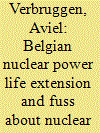

|
|
|
|
|
| Publication |
2013.
|
| Summary/Abstract |
Nuclear decision-making is embedded in slowly evolving political, economic and financial institutions. Belgium houses extended nuclear activities, mostly under French control, for example: SUEZ-GDF and EDF own all Belgian nuclear power plants. But a 2003 law mandates the closure of Belgium's nuclear power plants at a service age of 40 years; only force majeure could lift the strict obligation. Opposition to the law argued with climate change danger, financial losses, and loss-of-load risks. The financial issue got interwoven with a fuzzy debate on the definition, height and appropriation of “nuclear rents”. As plausible hypothesis is adopted: the prospected transfer of hundreds millions of euro from power companies to the public interest will create public support for life extension. But the nuclear rents discussion had faded in July 2012 when the Belgian government admitted a 10-year life extension for TIHANGE I (962 MW) and imposed the closure of the 2×433 MW DOEL I and II. Loss-of-load risk was the government's only public argument. The opacity of the decision process and its “fifty-fifty” outcome do not allow proper testing of the hypothesis. The case illustrates that politicians cannot bind their followers except through the deployment of alternative power sources.
|
|
|
|
|
|
|
|
|
|
|
|
|
|
|
|
| 8 |
ID:
124719


|
|
|
|
|
| Publication |
2013.
|
| Summary/Abstract |
The combination of bioenergy production and carbon capture and storage technologies (BECCS) provides an opportunity to create negative emissions of CO2 in biofuel production. However, high capture costs reduce profitability. This paper investigates carbon price uncertainty and technological uncertainty through a real option approach. We compare the cases of early and delayed CCS deployments. An early technological progress may arise from aggressive R&D and pilot project programs, but the expected cost reduction remains uncertain. We show that this approach results in lower emissions and more rapid investment returns although these returns will not fully materialise until after 2030. In a second set of simulations, we apply an incentive that prioritises sequestered emissions rather than avoided emissions. In other words, this economic instrument does not account for CO2 emissions from the CCS implementation itself, but rewards all the sequestered emissions. In contrast with technological innovations, this subsidy is certain for the investor. The resulting investment level is higher, and the project may become profitable before 2030. Negative emission in bioethanol production does not seem to be a short-term solution in our framework, whatever the carbon price drift.
|
|
|
|
|
|
|
|
|
|
|
|
|
|
|
|
| 9 |
ID:
124472


|
|
|
|
|
| Publication |
2013.
|
| Summary/Abstract |
Low carbon sustainability has been addressed in China's national development strategies. This research explores individual behaviour change and engagement in building low carbon communities in China through a case study looking at the building of a low carbon campus at Fudan University, Shanghai. Individual behaviour directly influences the overall energy consumption and carbon emissions on Fudan University's campus. Even though relevant polices have been issued for energy conservation, the energy consumption increased by 5% every year, which suggests that the "top-down" approach telling students and staff "what to do" does not work effectively. Based on a comprehensive method which includes the individual and social aspects related to the energy behaviour, the research analyses the promotion of individual engagement in building a low carbon campus through behaviour change based on four main aspects: (1) awareness raising and behaviour forming; (2) approaches to encourage behaviour change; (3) beyond the barriers and the constraints; and (4) systems and mechanisms for the long-term engagement. A low carbon management system is proposed for not only addressing management and technical solutions at the university level, but also based on the contributions from behaviour changes in establishing a low carbon campus at Fudan University at the individual level.
|
|
|
|
|
|
|
|
|
|
|
|
|
|
|
|
| 10 |
ID:
123730


|
|
|
|
|
| Publication |
2013.
|
| Summary/Abstract |
Growth patterns in the Gulf Cooperation Council (GCC) countries suggest that demand for energy in this region is likely to increase in the years to come and this situation ultimately means that more of the region's natural resources will need to be devoted to meeting this demand. For some of the GCC countries, the option to meet future power demands through alternative sources of energy such as nuclear power was deemed an attractive proposition.
Furthermore, real investments and plans to use other alternative energy sources such as solar, wind, hydrogen and geothermal are also gaining momentum in the region. However, relatively recent developments in the technology used for extracting gas and oil from shale rock formations places a big question mark on the GCC countries' energy plans including those relating to alternative and renewable sources of energy.
This article examines the GCC's new energy drive and explores the economic and political motivations behind it. Furthermore, the article also examines the potential impact of shale gas and oil extraction on this region's abundant fossil-based resources and the ramifications of such impact (if it materialises) for the GCC countries' alternative energy plans, future wealth and their political stability.
|
|
|
|
|
|
|
|
|
|
|
|
|
|
|
|
| 11 |
ID:
124444
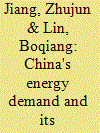

|
|
|
|
|
| Publication |
2013.
|
| Summary/Abstract |
Zhang and Qin (2013) argued that in Jiang and Lin (2012), the equation form and variable selection should be altered, and it was problematic to use regression equation to project the future. In this reply, we disagree with and will refute some of the points raised in their comments. The model that we established was based on the mature economic theory; with the variable selections all having economic implications. Considering the economic development stage, China's urbanization will speed up and this will have significant effect on energy consumption. Therefore, urbanization is an indispensable variable for analyzing energy demand in China. The scenario design only in terms of the GDP is sufficient for illustrating energy demand trend in China to be understood in a way by most of the people. Although energy forecast is not that precise, it has an important implication for energy policy design, especially for China which is in transition. And China's energy demand will keep high growth in the mid-term.
|
|
|
|
|
|
|
|
|
|
|
|
|
|
|
|
| 12 |
ID:
124674
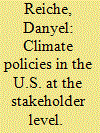

|
|
|
|
|
| Publication |
2013.
|
| Summary/Abstract |
This article analyzes how stakeholders are able to influence climate policy-making in the U.S.; emphasis is placed upon the most popular sports league in the United States, the National Football League (NFL). An empirical analysis of the 32 NFL franchises identifies pioneering clubs that have introduced ambitious green programs that include the utilization of renewable energies, the adoption of energy efficiency measures and carbon offsetting policies, as well as the facilitation of public transport and electric cars. Apart from environmental concerns, this paper identifies several drivers for pioneering actions: economic motives, pressure exerted by the local environment, public relations, and political incentives such as the promotion from the federal government's stimulus package. Finally, this article investigates the role that state actors, such as the Environmental Protection Agency, and non-state actors, such as the Natural Resources Defense Council, play in the innovation and diffusion processes of environmental programs in the NFL.
|
|
|
|
|
|
|
|
|
|
|
|
|
|
|
|
| 13 |
ID:
124333
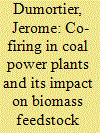

|
|
|
|
|
| Summary/Abstract |
Several states have a renewable portfolio standard (RPS) and allow for biomass co-firing to meet the RPS requirements. In addition, a federal renewable fuel standard (RFS) mandates an increase in cellulosic ethanol production over the next decade. This paper quantifies the effects on local biomass supply and demand of different co-firing policies imposed on 398 existing coal-fired power plants. Our model indicates which counties are most likely to be able to sustain cellulosic ethanol plants in addition to co-firing electric utilities. The simulation incorporates the county-level biomass market of corn stover, wheat straw, switchgrass, and forest residues as well as endogenous crop prices. Our scenarios indicate that there is sufficient feedstock availability in Southern Minnesota, Iowa, and Central Illinois. Significant supply shortages are observed in Eastern Ohio, Western Pennsylvania, and the tri-state area of Illinois, Indiana, and Kentucky which are characterized by a high density of coal-fired power plants with high energy output.
|
|
|
|
|
|
|
|
|
|
|
|
|
|
|
|
| 14 |
ID:
124085


|
|
|
|
|
| Publication |
2013.
|
| Summary/Abstract |
Jacobson et al. (2013) recently published a paper arguing the feasibility of meeting all of the energy demands in New York State with wind, solar, and water resources. In this forum we suggest that the authors do not present sufficient analysis to demonstrate the technical, economic, and social feasibility of their proposed strategy.
|
|
|
|
|
|
|
|
|
|
|
|
|
|
|
|
| 15 |
ID:
124506
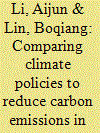

|
|
|
|
|
| Publication |
2013.
|
| Summary/Abstract |
Currently, China is the largest carbon emitter mainly due to growing consumption of fossil fuels. In 2009, the Chinese government committed itself to reducing domestic carbon emissions per unit of GDP by 40-45% by 2020 compared to 2005 levels. Therefore, it is a top priority for the Chinese government to adopt efficient policy instruments to reduce its carbon intensity. Against this background, this paper develops a general equilibrium model and seeks to provide empirical contributions by comparing the potential impacts of several different policy options to reduce China's carbon emissions. The main findings are as follows. Firstly, these climate policies would affect the structure of economy and contribute to carbon emissions reduction and carbon intensity reduction. Secondly, there would be significant differences in the economic and environmental effects among different climate policies and hence, the government would trade-off among different economic objectives to overcome any potential resistances. Thirdly, there would be considerable differences in the emissions effects of absolute and intensity-based carbon emissions controls, implying that the government might adopt different climate policies for absolute or intensity-based carbon emissions controls. Looking ahead, the government should trade-off among different objectives when designing climate reforms.
|
|
|
|
|
|
|
|
|
|
|
|
|
|
|
|
| 16 |
ID:
124477


|
|
|
|
|
| Publication |
2013.
|
| Summary/Abstract |
This paper provides an insight into consumer engagement in smart grid projects in Europe. Projects analysed are those included in the catalogue annexed in the JRC Report "Smart Grid projects in Europe: lessons learned and current developments". The analysis suggests an increase in the interest in consumer engagement projects at European level and a strong focus on the residential sector, and emphasises the key importance of public funding to support these projects. The study also reveals that projects involving consumers are characterised by the pursuit of two main objectives: gaining deeper knowledge of consumer behaviour (observing and understanding the consumer) and motivating and empowering consumers to become active energy customers (engaging the consumer). The paper reviews the main activities undertaken to obtain these objectives and highlights trends and developments in the field. Finally, the paper discusses obstacles to consumer engagement and the strategies adopted by the projects surveyed to tackle them, highlighting the need to build consumer trust and to design targeted campaigns taking into consideration different consumer segments. The conclusions are in line with findings and analyses presented in the literature and underscore the need for further research and action at European level.
|
|
|
|
|
|
|
|
|
|
|
|
|
|
|
|
| 17 |
ID:
124503


|
|
|
|
|
| Publication |
2013.
|
| Summary/Abstract |
The Covenant of Mayors (COM) initiative invites cities to commit themselves to reduce voluntarily the greenhouse gas emissions within their territories. This manuscript presents the COM initiative and analyzes its mechanisms. In order to better quantify the penetration of the initiative, the authors introduce suitable "participation factors". Moreover, a study and a survey are presented concerning the COM initiative in Greece. Certain barriers are identified preventing the realization of the initiative's full potential in Greece. Results from the public survey indicate lack of proper information and communication about the COM initiative and the obligations arising from its signing towards the citizens itself. Nevertheless, once the citizens are informed properly, the public acceptance of the initiative and its commitments is considerable, to the extent that its success would influence the vote of a substantial percentage of citizens. The positive role of supporting structures is evaluated and may be demonstrated through the survey's results and discussion. Recommendations are provided for future or existing signatories based on the findings of this work.
|
|
|
|
|
|
|
|
|
|
|
|
|
|
|
|
| 18 |
ID:
124693


|
|
|
|
|
| Publication |
2013.
|
| Summary/Abstract |
This paper presents an alternative approach to a graphical analysis of the interaction of White Certificates with the EU emission trading scheme as the approach of Sorrell et al. (2009a contains the following aspects that require some clarification: first, the issue of a clearer distinction between conventional and alternative energy supply is brought up. Second, the concept of a minimum requirement for energy demanded is discussed. Third, the correlation between demand for energy and demand for energy efficiency measures is displayed in a more intuitive manner. The effects of introducing WCTS and EU ETS into the market setting are then analyzed accordingly.
|
|
|
|
|
|
|
|
|
|
|
|
|
|
|
|
| 19 |
ID:
124162


|
|
|
|
|
| Publication |
2013.
|
| Summary/Abstract |
Turkey's Energy Efficiency Law (EEL), enacted in 2007, had been expected to transform the energy policies in government and private sectors, and offer opportunities for, then-impending, Turkish Energy Service Company (ESCO) market. Yet, the communiqué of the EEL related to ESCOs was released only recently in July 2012. In this work, we review the current status of the ESCO market in Turkey. We provide an outlook through the recent legal communiqué and present barriers, enabling factors, and opportunities, supported by country's financial and economic facts. ESCO-financing mechanism prevailing and the sources of financing in the country are also mentioned. The communiqué on ESCOs fits well in the chain of regulatory attempts to increase Turkey's competitiveness in the global markets. However, we anticipate that some of its principles and procedures to be enforced may be deterrent for small-scale candidate ESCOs and may slow down the expected development of the Turkish ESCO market. Otherwise, the communiqué should lead restructuring of a stronger ESCO market in Turkey.
|
|
|
|
|
|
|
|
|
|
|
|
|
|
|
|
| 20 |
ID:
124179


|
|
|
|
|
| Publication |
2013.
|
| Summary/Abstract |
Ambitious targets have been set for expanding electricity generation from renewable sources, including wind. Expanding wind power impacts needs for other electricity generating resources. As states plan for increasing levels of wind generation in their portfolio of generation resources it is important to consider how this intermittent resource impacts the need for other generation resources. A case study for Indiana estimates the value of wind capacity and demonstrates how to optimize its level and the levels of other generation resources. Changes are driven by temporal patterns of wind power output and load. System wide impacts are calculated for energy, capacity, and costs under multiple wind expansion scenarios which highlight the geographic characteristics of a systems portfolio of wind generation. The impacts of carbon prices, as proposed in the Bingaman Bill, are considered. Finally, calculations showing the effect increasing levels of wind generation will have on end use Indiana retail rates are included.
|
|
|
|
|
|
|
|
|
|
|
|
|
|
|
|
|
|
|
|
|